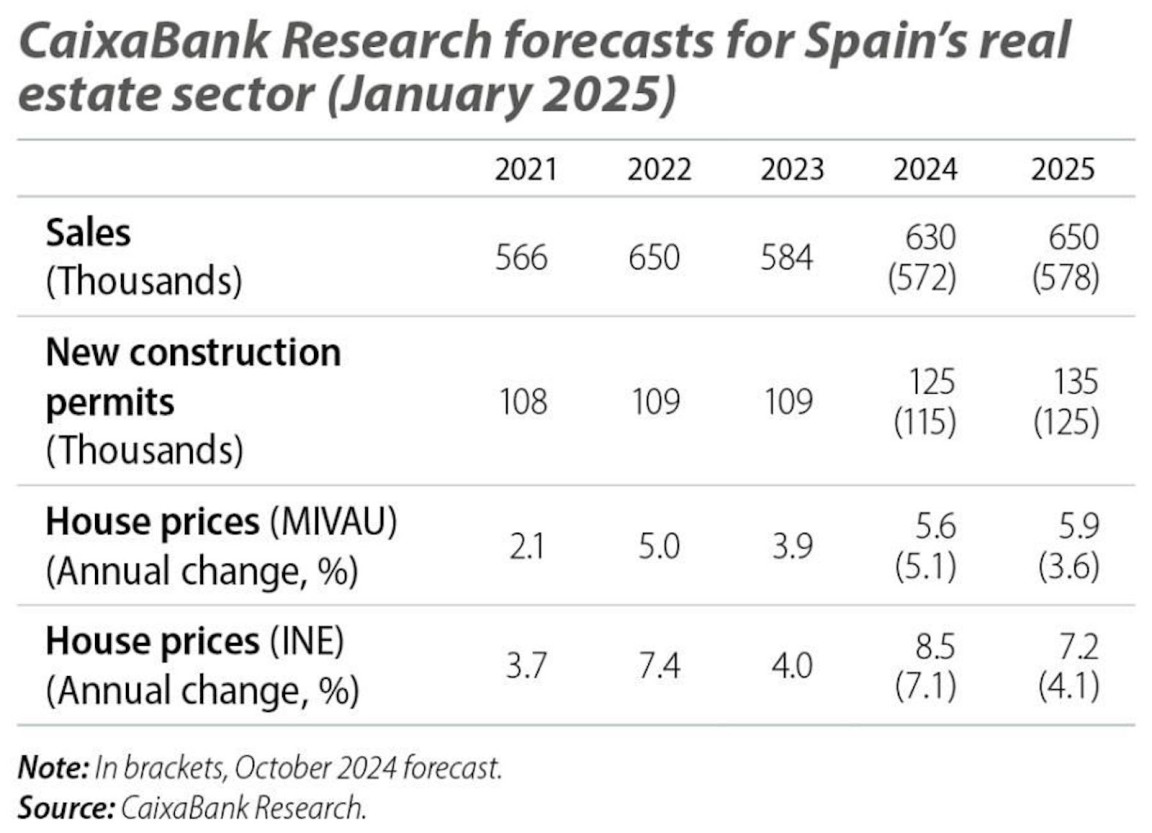22 trends & predictions for the Spanish real estate market in 2025
Post published in News
Spain’s property market hit record highs in 2024 – find out what's in store for 2025.

*This article was updated on 13th March 2025 with the latest statistics and predictions.
Looking for an overview of the Spanish real estate market?
In this article, we’ve poured over the leading sources of information on Spanish real estate trends, housing prices, and expert forecasts for 2025.
This includes the trends & predictions from:
The Colegio de Registradores (official body managing Spain’s land registry)
The Consejo General del Notariado (official body of Spanish notaries)
The Instituto Nacional de Estadistica (Spain’s national institute of statistics)
Banco de España (Spain’s central bank)
Ministerio de Vivienda y Agenda Urbana (Spanish Ministry of Housing)
If you’d like to dig into the data, we recommend you locate reports from these sources above.
But for a quick overview, find 22 important insights compiled below.
22 statistics on the Spanish real estate market in 2025
Spanish real estate trends
Market trends
Property sales growth – Property sales in Spain rose 11.5% in 2024, reaching 716,183 transactions—an increase of 73,622 sales compared to 2023, according to the Consejo General del Notariado.
Apartment and house sales – Both apartments and houses experienced similar growth in sales. Apartment sales increased by 11.4% year-over-year, reaching 550,753 transactions, while single-family homes rose by 11.6%, totaling 165,430 sales in 2024.
Registered transactions – The number of registered property sales in Q4 2024 increased by 3.6% from the previous quarter, reaching 172,551 transactions—the highest level since Q3 2007. Compared to Q4 2023, sales surged by 32.9%, further reinforcing that housing market activity has exceeded pre-crisis levels for the first time.

Housing price trends
Price per square meter – The average price per square meter reached €1,753/m² in 2024, marking a 6.9% annual increase. This brought prices back to 2007 levels for the first time, according to the Consejo General del Notariado.
Housing Price Index (IPV) – Spain’s Housing Price Index, which tracks price changes in new and second-hand homes, rose by 11.3% in Q4 2024, up 3.2 points from the previous year, indicating a sustained increase in property values, according to the Instituto Nacional de Estadística (INE).
Repeat Sales Index (IPVVR) – The Housing Price Index for Repeat Sales, published by the Colegio de Registradores, grew 1.71% in Q4 2024, marking five consecutive quarters of growth and reaching a new all-time high—12.5% above its 2007 peak. This aligns with notary data, confirming that Spain’s property values have fully recovered and surpassed pre-financial crisis levels.
Supply shortage – CaixaBank reports that the main factor driving housing price increases in Spain is a lack of available properties relative to demand. While new construction permits have increased (126,761 permits in the 12 months up to November 2024), the supply remains too weak to meet demand, pushing prices higher.
New home construction – A total of 112,000 new homes were built in 2024, according to the Estadística Continua de Población. This figure is significantly lower than the growth in Spain’s population, which increased by 458,000 people (+0.9%) in 2024, primarily due to immigration.

Foreign buyer trends
Foreign demand – Foreign buyers accounted for 14.6% of all property purchases in Spain in 2024, totaling approximately 93,000 transactions, according to the Colegio de Registradores. This represents a 6.4% increase from 2023 and is just short of the record high of 94,500 foreign purchases in 2022.
Top provinces – While full-year data from the Colegio de Registradores is not yet available at the time of writing, Q4 2024 figures suggest that foreign buyers were most active in Alicante (45.67%), Balearic Islands (32.81%), Málaga (32.35%), Santa Cruz de Tenerife (30.66%), Girona (28.86%), Murcia (22.84%), Almería (20.06%), and Las Palmas (19.71%).
Foreign nationalities – Q4 2024 data shows that the largest groups of foreign buyers were British (8.57%), Germans (6.67%), Dutch (5.91%), Moroccans (5.30%), French (5.28%), Romanians (5.17%), and Italians (4.76%). The proportion of British buyers has fallen significantly from its quarterly high of nearly 24% in early 2016, reflecting shifting market dynamics.
Non-resident buyer trends – Non-resident foreign buyers purchase more expensive properties on average than both foreign residents and Spanish nationals. British, German, Dutch, Belgian, and French buyers make up 48.5% of all non-resident foreign purchases, indicating a strong demand for high-value properties among these nationalities.


Investment trends
Rental yield and price growth – Full-year data from the Banco de España is not yet available, but preliminary figures from Q1-Q3 2024 indicate that the average rentabilidad de vivienda (rental yield plus price variation) reached 10.8%. This marks a significant increase from 7.7% in 2023, highlighting growing returns for property investors.
Rental yield comparison – The gross rental yield (annual rental income as a percentage of property price) stood at 3.3% in 2024. This was higher than Spain’s 10-year government bonds (3.1%) and household deposits and ISFLSH deposits (2.5%, Non-Profit Institutions Serving Households), making real estate a more attractive investment compared to these traditional financial instruments.
Predictions
Market predictions
Property sales forecast – CaixaBank Research forecasts that 650,000 properties will be sold in 2025, marking a decline from 716,183 sales in 2024. This represents a return to 2022 sales levels, suggesting a slowdown in transaction volume.

Housing price predictions
Home price outlook – CaixaBank Research expects the rally in home prices to continue in 2025, with an estimated nominal growth of 4%. This rate is projected to outpace inflation (1.9%) and GDP growth (2.1%), as forecasted by the IMF, reinforcing expectations of continued price appreciation in the housing market.
Mortgage improvements – The European Central Bank (ECB) reduced interest rates four times in 2024, bringing them down to 3%, the lowest level since March 2023. Further cuts are expected in 2025, improving mortgage affordability and stimulating demand. As borrowing conditions ease, increased demand could add further pressure to the housing market, driving prices higher.
New build price growth – According to the Spanish Ministry of Housing, 107,098 new construction permits were issued between January and October 2024, marking a 16.48% increase compared to the same period in the previous year. This rising supply of new homes is expected to moderate price increases in the new build market, with David Martínez, CEO of Aedas Homes, forecasting price growth of 4-5% in 2025.

Foreign buyer predictions
Golden visa impact – Spain’s golden visa program, launched in 2013, allowed non-EU residents to obtain residency by making significant investments, including property purchases over €500,000. Between 2013 and October 2024, 15,149 golden visas were granted in connection with real estate investments. This pathway is no longer available from April 2025 – but CaixaBank Research predicts it will have little impact on foreign demand as such purchases represent a small fraction of the market.
Potential threats to non-EU foreign buyers – In January 2025, the Spanish government proposed a 100% property tax on non-EU & non-resident foreign buyers, meaning they would have to pay the full value of their purchased property in taxes. While this proposal faces significant opposition and critics believe it is unlikely to pass in its current form, it represents a key uncertainty for non-EU (and non-resident) investors considering property purchases in Spain.
Investment predictions
Potential threats to touristic rentals – Several local governments in touristic cities like Málaga and Barcelona have announced restrictions on new licenses for short-term rental properties, aiming to curb rising housing costs for locals. These regulations could limit the potential rental returns for investment properties in affected areas.
Potential incentives for long-term rentals – Other proposed government policies could increase long-term rental prices. Among the January 2025 housing measures, the government announced a 100% personal income tax exemption for landlords who rent properties at rates aligned with the Reference Price Index. Economist Miguel Córdoba predicts that further government intervention, including possible cash supplements to renters, could amplify rental market pressure – especially in high-demand cities. He predicts rental prices could rise by 5-10% in popular locations like Madrid, Barcelona, Málaga, Mallorca, and Ibiza in 2025.

Frequently asked questions
Are property prices dropping in Spain in 2025?
No, property prices in Spain are not dropping in 2025. According to CaixaBank Research, home prices are expected to grow by 4% this year, outpacing inflation and GDP growth. The market remains strong due to high demand, a limited supply of new homes, and improving mortgage conditions.
What is the forecast for Spanish property prices in 2025?
Spanish property prices are forecast to rise by 4% in 2025, continuing the upward trend seen in recent years. New build prices may increase by 4-5%, while second-hand homes are also expected to appreciate. Rising demand, lower interest rates, and supply shortages are key factors driving price growth.
Is now a good time to buy property in Spain?
Yes, now is a good time to buy property in Spain, especially before prices rise further. Mortgage affordability is improving due to expected interest rate cuts, and property values are still climbing. However, buyers should consider location-specific factors, as some areas may experience slower growth or increased regulation on rental properties.
What’s the average house price in Spain?
The average price per square meter in Spain reached €1,753 in 2024, marking a 6.9% annual increase. This means a 100m² home would cost around €175,300 on average, though prices vary significantly by region. Popular areas like Madrid, Barcelona, and coastal destinations tend to be much higher.
How long will Spain’s housing prices bubble last?
Spain’s housing market is experiencing strong growth, but experts do not consider it a bubble. Prices are increasing due to real demand, supply shortages, and economic factors rather than speculation. As long as supply remains tight and interest rates stay favorable, price growth is expected to continue into 2026.
Post published 13/03/2025 in News



